PUBH6007 Program Design, Implementation & Evaluation: Needs Assessment
VerifiedAdded on 2022/08/25
|8
|2045
|16
Report
AI Summary
This report presents a needs assessment of primary healthcare services in a Melbourne suburb, focusing on the critical shortage of nurses and its impact on the community. The assessment identifies key issues such as the unavailability of nursing care, long wait times for services, and the lack of after-hours support, leading to health inequalities and challenges for residents, especially in rural areas. The report analyzes different types of needs (normative, expressed, comparative, and felt) and prioritizes the findings based on the severity of the issues. It explores the SWOT analysis of the situation, highlighting the existing strengths (trained nurses) and weaknesses (location) as well as opportunities (shift work) and threats (increasing patient complexity). The report also examines the impact of the nursing shortage on patient care, the importance of primary health care, and references relevant literature to support its findings, emphasizing the need for improved workforce distribution and innovative healthcare models like the “fly-in-fly-out” and “drive-in drive-out” models to address the healthcare needs of the community. The report concludes by suggesting recommendations for improving healthcare access and equity, such as allocating shifts to nurses in city hospitals to serve rural areas and improve health outcomes.
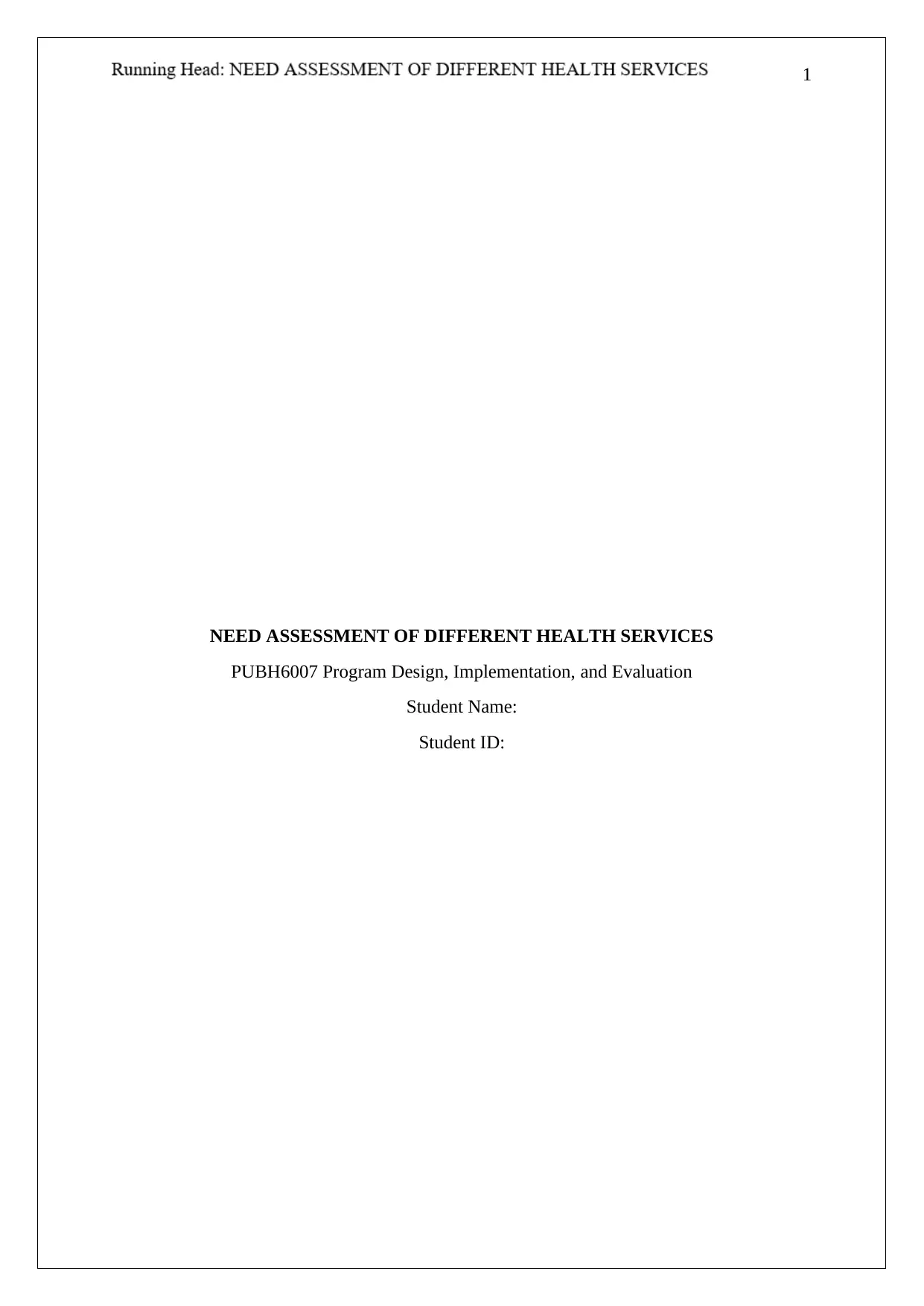
1
NEED ASSESSMENT OF DIFFERENT HEALTH SERVICES
PUBH6007 Program Design, Implementation, and Evaluation
Student Name:
Student ID:
NEED ASSESSMENT OF DIFFERENT HEALTH SERVICES
PUBH6007 Program Design, Implementation, and Evaluation
Student Name:
Student ID:
Paraphrase This Document
Need a fresh take? Get an instant paraphrase of this document with our AI Paraphraser
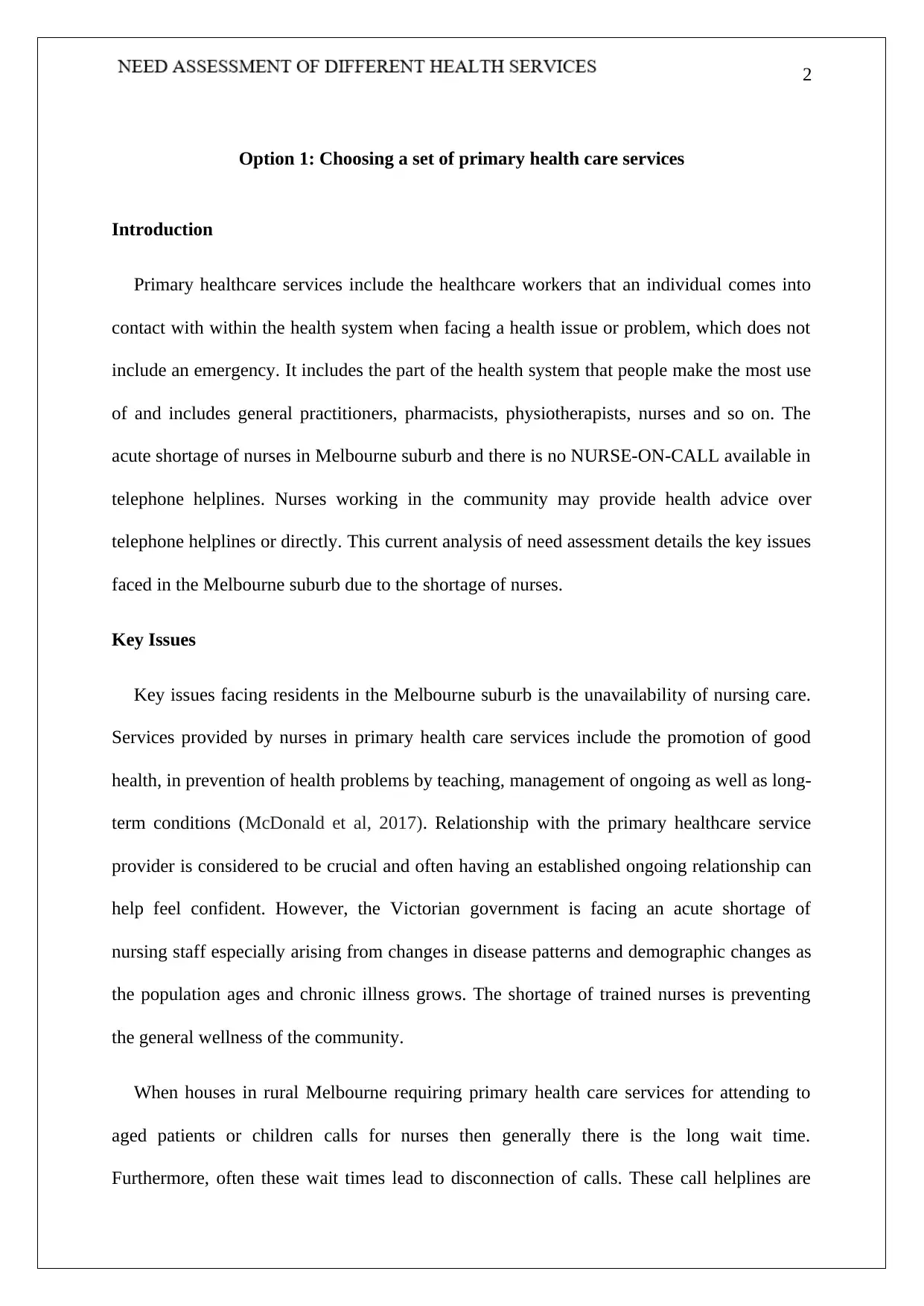
2
Option 1: Choosing a set of primary health care services
Introduction
Primary healthcare services include the healthcare workers that an individual comes into
contact with within the health system when facing a health issue or problem, which does not
include an emergency. It includes the part of the health system that people make the most use
of and includes general practitioners, pharmacists, physiotherapists, nurses and so on. The
acute shortage of nurses in Melbourne suburb and there is no NURSE-ON-CALL available in
telephone helplines. Nurses working in the community may provide health advice over
telephone helplines or directly. This current analysis of need assessment details the key issues
faced in the Melbourne suburb due to the shortage of nurses.
Key Issues
Key issues facing residents in the Melbourne suburb is the unavailability of nursing care.
Services provided by nurses in primary health care services include the promotion of good
health, in prevention of health problems by teaching, management of ongoing as well as long-
term conditions (McDonald et al, 2017). Relationship with the primary healthcare service
provider is considered to be crucial and often having an established ongoing relationship can
help feel confident. However, the Victorian government is facing an acute shortage of
nursing staff especially arising from changes in disease patterns and demographic changes as
the population ages and chronic illness grows. The shortage of trained nurses is preventing
the general wellness of the community.
When houses in rural Melbourne requiring primary health care services for attending to
aged patients or children calls for nurses then generally there is the long wait time.
Furthermore, often these wait times lead to disconnection of calls. These call helplines are
Option 1: Choosing a set of primary health care services
Introduction
Primary healthcare services include the healthcare workers that an individual comes into
contact with within the health system when facing a health issue or problem, which does not
include an emergency. It includes the part of the health system that people make the most use
of and includes general practitioners, pharmacists, physiotherapists, nurses and so on. The
acute shortage of nurses in Melbourne suburb and there is no NURSE-ON-CALL available in
telephone helplines. Nurses working in the community may provide health advice over
telephone helplines or directly. This current analysis of need assessment details the key issues
faced in the Melbourne suburb due to the shortage of nurses.
Key Issues
Key issues facing residents in the Melbourne suburb is the unavailability of nursing care.
Services provided by nurses in primary health care services include the promotion of good
health, in prevention of health problems by teaching, management of ongoing as well as long-
term conditions (McDonald et al, 2017). Relationship with the primary healthcare service
provider is considered to be crucial and often having an established ongoing relationship can
help feel confident. However, the Victorian government is facing an acute shortage of
nursing staff especially arising from changes in disease patterns and demographic changes as
the population ages and chronic illness grows. The shortage of trained nurses is preventing
the general wellness of the community.
When houses in rural Melbourne requiring primary health care services for attending to
aged patients or children calls for nurses then generally there is the long wait time.
Furthermore, often these wait times lead to disconnection of calls. These call helplines are
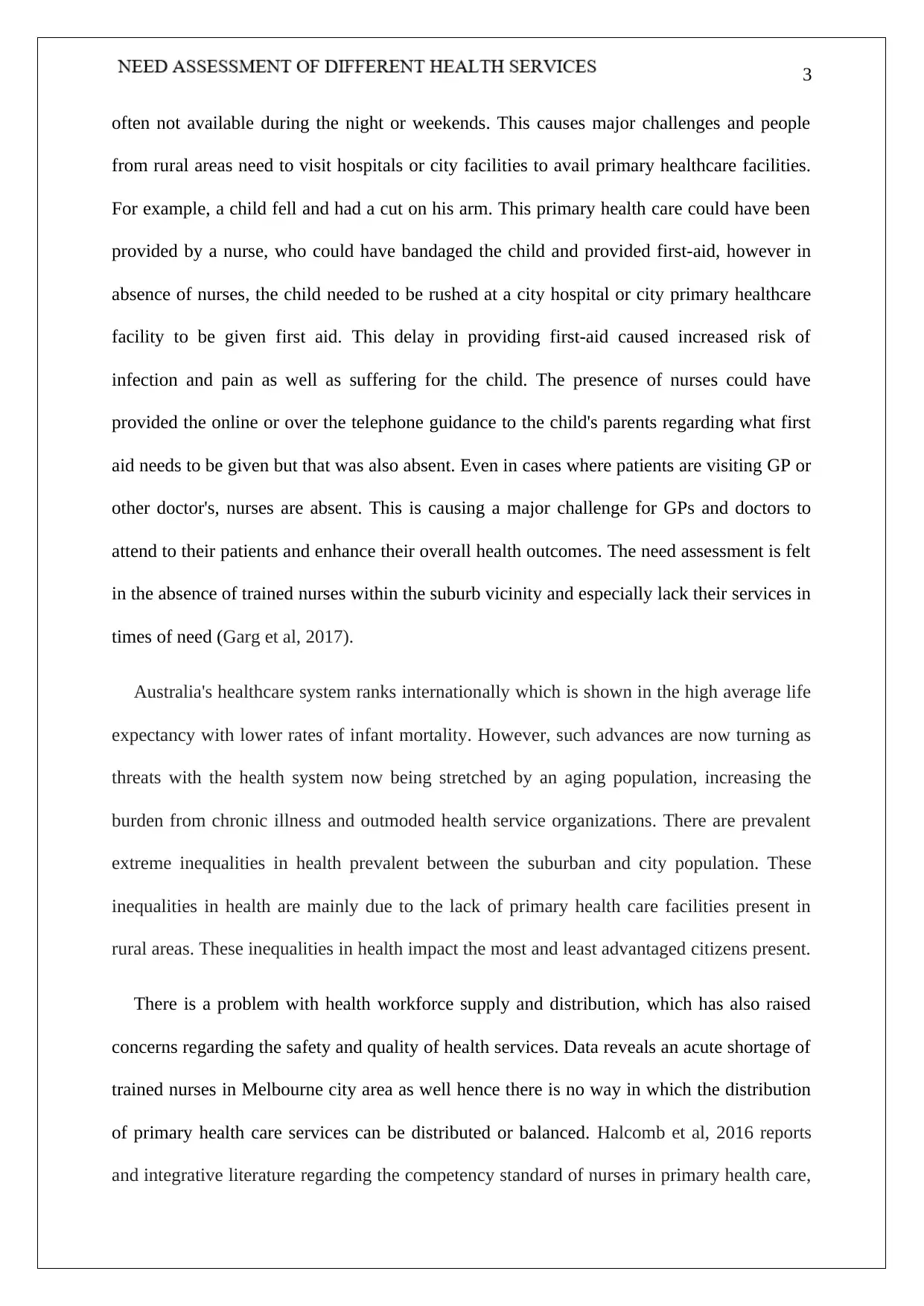
3
often not available during the night or weekends. This causes major challenges and people
from rural areas need to visit hospitals or city facilities to avail primary healthcare facilities.
For example, a child fell and had a cut on his arm. This primary health care could have been
provided by a nurse, who could have bandaged the child and provided first-aid, however in
absence of nurses, the child needed to be rushed at a city hospital or city primary healthcare
facility to be given first aid. This delay in providing first-aid caused increased risk of
infection and pain as well as suffering for the child. The presence of nurses could have
provided the online or over the telephone guidance to the child's parents regarding what first
aid needs to be given but that was also absent. Even in cases where patients are visiting GP or
other doctor's, nurses are absent. This is causing a major challenge for GPs and doctors to
attend to their patients and enhance their overall health outcomes. The need assessment is felt
in the absence of trained nurses within the suburb vicinity and especially lack their services in
times of need (Garg et al, 2017).
Australia's healthcare system ranks internationally which is shown in the high average life
expectancy with lower rates of infant mortality. However, such advances are now turning as
threats with the health system now being stretched by an aging population, increasing the
burden from chronic illness and outmoded health service organizations. There are prevalent
extreme inequalities in health prevalent between the suburban and city population. These
inequalities in health are mainly due to the lack of primary health care facilities present in
rural areas. These inequalities in health impact the most and least advantaged citizens present.
There is a problem with health workforce supply and distribution, which has also raised
concerns regarding the safety and quality of health services. Data reveals an acute shortage of
trained nurses in Melbourne city area as well hence there is no way in which the distribution
of primary health care services can be distributed or balanced. Halcomb et al, 2016 reports
and integrative literature regarding the competency standard of nurses in primary health care,
often not available during the night or weekends. This causes major challenges and people
from rural areas need to visit hospitals or city facilities to avail primary healthcare facilities.
For example, a child fell and had a cut on his arm. This primary health care could have been
provided by a nurse, who could have bandaged the child and provided first-aid, however in
absence of nurses, the child needed to be rushed at a city hospital or city primary healthcare
facility to be given first aid. This delay in providing first-aid caused increased risk of
infection and pain as well as suffering for the child. The presence of nurses could have
provided the online or over the telephone guidance to the child's parents regarding what first
aid needs to be given but that was also absent. Even in cases where patients are visiting GP or
other doctor's, nurses are absent. This is causing a major challenge for GPs and doctors to
attend to their patients and enhance their overall health outcomes. The need assessment is felt
in the absence of trained nurses within the suburb vicinity and especially lack their services in
times of need (Garg et al, 2017).
Australia's healthcare system ranks internationally which is shown in the high average life
expectancy with lower rates of infant mortality. However, such advances are now turning as
threats with the health system now being stretched by an aging population, increasing the
burden from chronic illness and outmoded health service organizations. There are prevalent
extreme inequalities in health prevalent between the suburban and city population. These
inequalities in health are mainly due to the lack of primary health care facilities present in
rural areas. These inequalities in health impact the most and least advantaged citizens present.
There is a problem with health workforce supply and distribution, which has also raised
concerns regarding the safety and quality of health services. Data reveals an acute shortage of
trained nurses in Melbourne city area as well hence there is no way in which the distribution
of primary health care services can be distributed or balanced. Halcomb et al, 2016 reports
and integrative literature regarding the competency standard of nurses in primary health care,
⊘ This is a preview!⊘
Do you want full access?
Subscribe today to unlock all pages.

Trusted by 1+ million students worldwide
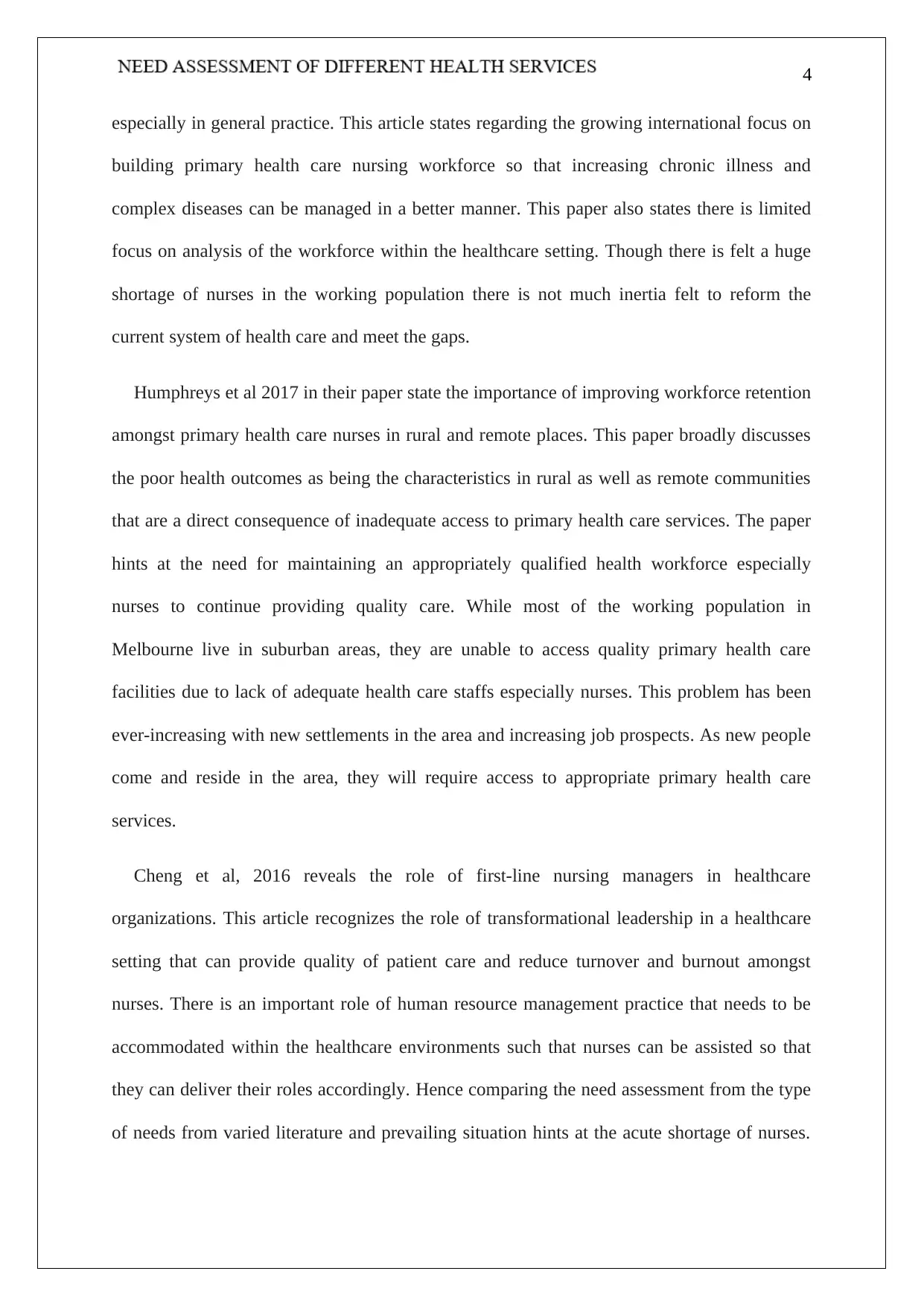
4
especially in general practice. This article states regarding the growing international focus on
building primary health care nursing workforce so that increasing chronic illness and
complex diseases can be managed in a better manner. This paper also states there is limited
focus on analysis of the workforce within the healthcare setting. Though there is felt a huge
shortage of nurses in the working population there is not much inertia felt to reform the
current system of health care and meet the gaps.
Humphreys et al 2017 in their paper state the importance of improving workforce retention
amongst primary health care nurses in rural and remote places. This paper broadly discusses
the poor health outcomes as being the characteristics in rural as well as remote communities
that are a direct consequence of inadequate access to primary health care services. The paper
hints at the need for maintaining an appropriately qualified health workforce especially
nurses to continue providing quality care. While most of the working population in
Melbourne live in suburban areas, they are unable to access quality primary health care
facilities due to lack of adequate health care staffs especially nurses. This problem has been
ever-increasing with new settlements in the area and increasing job prospects. As new people
come and reside in the area, they will require access to appropriate primary health care
services.
Cheng et al, 2016 reveals the role of first-line nursing managers in healthcare
organizations. This article recognizes the role of transformational leadership in a healthcare
setting that can provide quality of patient care and reduce turnover and burnout amongst
nurses. There is an important role of human resource management practice that needs to be
accommodated within the healthcare environments such that nurses can be assisted so that
they can deliver their roles accordingly. Hence comparing the need assessment from the type
of needs from varied literature and prevailing situation hints at the acute shortage of nurses.
especially in general practice. This article states regarding the growing international focus on
building primary health care nursing workforce so that increasing chronic illness and
complex diseases can be managed in a better manner. This paper also states there is limited
focus on analysis of the workforce within the healthcare setting. Though there is felt a huge
shortage of nurses in the working population there is not much inertia felt to reform the
current system of health care and meet the gaps.
Humphreys et al 2017 in their paper state the importance of improving workforce retention
amongst primary health care nurses in rural and remote places. This paper broadly discusses
the poor health outcomes as being the characteristics in rural as well as remote communities
that are a direct consequence of inadequate access to primary health care services. The paper
hints at the need for maintaining an appropriately qualified health workforce especially
nurses to continue providing quality care. While most of the working population in
Melbourne live in suburban areas, they are unable to access quality primary health care
facilities due to lack of adequate health care staffs especially nurses. This problem has been
ever-increasing with new settlements in the area and increasing job prospects. As new people
come and reside in the area, they will require access to appropriate primary health care
services.
Cheng et al, 2016 reveals the role of first-line nursing managers in healthcare
organizations. This article recognizes the role of transformational leadership in a healthcare
setting that can provide quality of patient care and reduce turnover and burnout amongst
nurses. There is an important role of human resource management practice that needs to be
accommodated within the healthcare environments such that nurses can be assisted so that
they can deliver their roles accordingly. Hence comparing the need assessment from the type
of needs from varied literature and prevailing situation hints at the acute shortage of nurses.
Paraphrase This Document
Need a fresh take? Get an instant paraphrase of this document with our AI Paraphraser
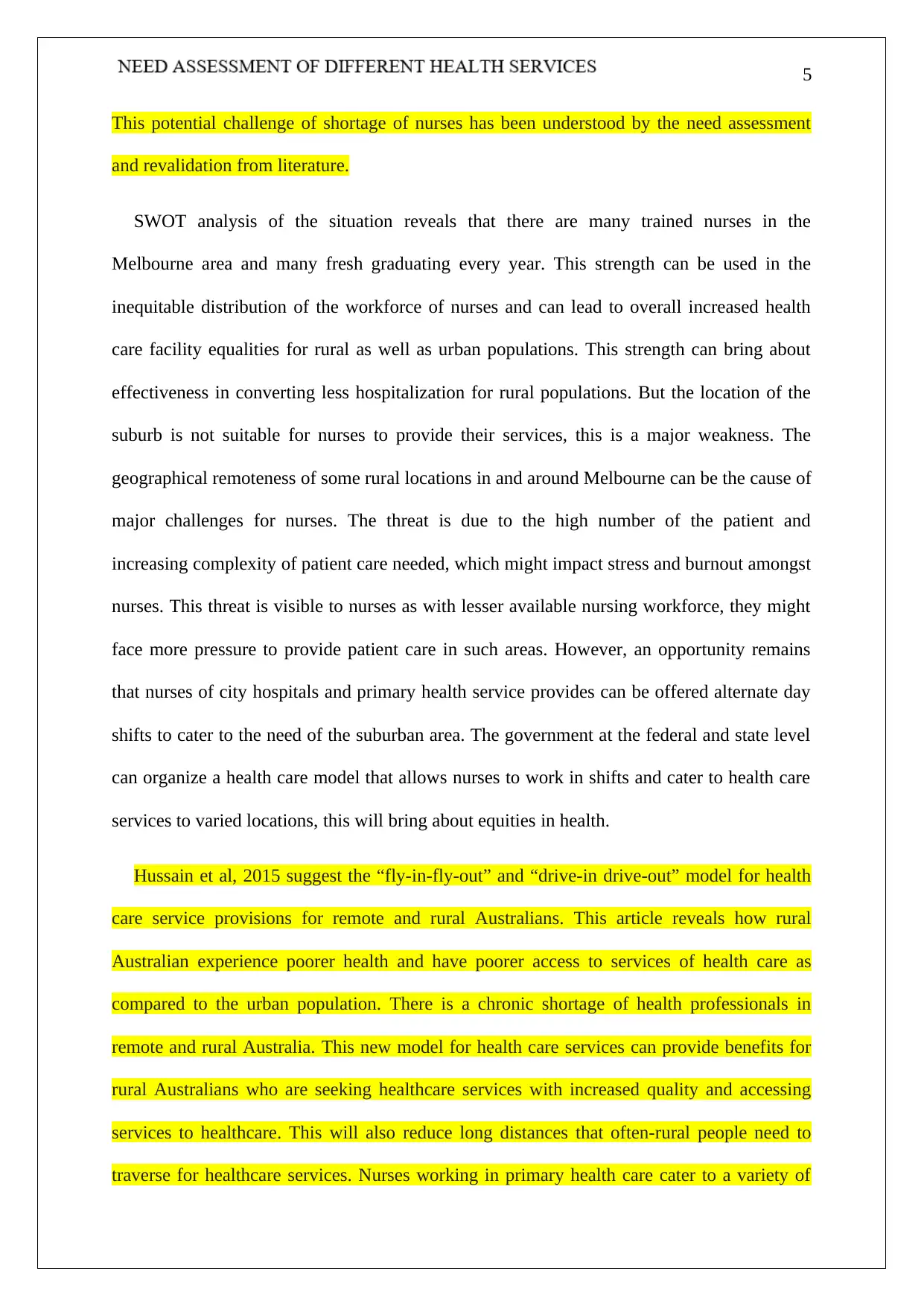
5
This potential challenge of shortage of nurses has been understood by the need assessment
and revalidation from literature.
SWOT analysis of the situation reveals that there are many trained nurses in the
Melbourne area and many fresh graduating every year. This strength can be used in the
inequitable distribution of the workforce of nurses and can lead to overall increased health
care facility equalities for rural as well as urban populations. This strength can bring about
effectiveness in converting less hospitalization for rural populations. But the location of the
suburb is not suitable for nurses to provide their services, this is a major weakness. The
geographical remoteness of some rural locations in and around Melbourne can be the cause of
major challenges for nurses. The threat is due to the high number of the patient and
increasing complexity of patient care needed, which might impact stress and burnout amongst
nurses. This threat is visible to nurses as with lesser available nursing workforce, they might
face more pressure to provide patient care in such areas. However, an opportunity remains
that nurses of city hospitals and primary health service provides can be offered alternate day
shifts to cater to the need of the suburban area. The government at the federal and state level
can organize a health care model that allows nurses to work in shifts and cater to health care
services to varied locations, this will bring about equities in health.
Hussain et al, 2015 suggest the “fly-in-fly-out” and “drive-in drive-out” model for health
care service provisions for remote and rural Australians. This article reveals how rural
Australian experience poorer health and have poorer access to services of health care as
compared to the urban population. There is a chronic shortage of health professionals in
remote and rural Australia. This new model for health care services can provide benefits for
rural Australians who are seeking healthcare services with increased quality and accessing
services to healthcare. This will also reduce long distances that often-rural people need to
traverse for healthcare services. Nurses working in primary health care cater to a variety of
This potential challenge of shortage of nurses has been understood by the need assessment
and revalidation from literature.
SWOT analysis of the situation reveals that there are many trained nurses in the
Melbourne area and many fresh graduating every year. This strength can be used in the
inequitable distribution of the workforce of nurses and can lead to overall increased health
care facility equalities for rural as well as urban populations. This strength can bring about
effectiveness in converting less hospitalization for rural populations. But the location of the
suburb is not suitable for nurses to provide their services, this is a major weakness. The
geographical remoteness of some rural locations in and around Melbourne can be the cause of
major challenges for nurses. The threat is due to the high number of the patient and
increasing complexity of patient care needed, which might impact stress and burnout amongst
nurses. This threat is visible to nurses as with lesser available nursing workforce, they might
face more pressure to provide patient care in such areas. However, an opportunity remains
that nurses of city hospitals and primary health service provides can be offered alternate day
shifts to cater to the need of the suburban area. The government at the federal and state level
can organize a health care model that allows nurses to work in shifts and cater to health care
services to varied locations, this will bring about equities in health.
Hussain et al, 2015 suggest the “fly-in-fly-out” and “drive-in drive-out” model for health
care service provisions for remote and rural Australians. This article reveals how rural
Australian experience poorer health and have poorer access to services of health care as
compared to the urban population. There is a chronic shortage of health professionals in
remote and rural Australia. This new model for health care services can provide benefits for
rural Australians who are seeking healthcare services with increased quality and accessing
services to healthcare. This will also reduce long distances that often-rural people need to
traverse for healthcare services. Nurses working in primary health care cater to a variety of
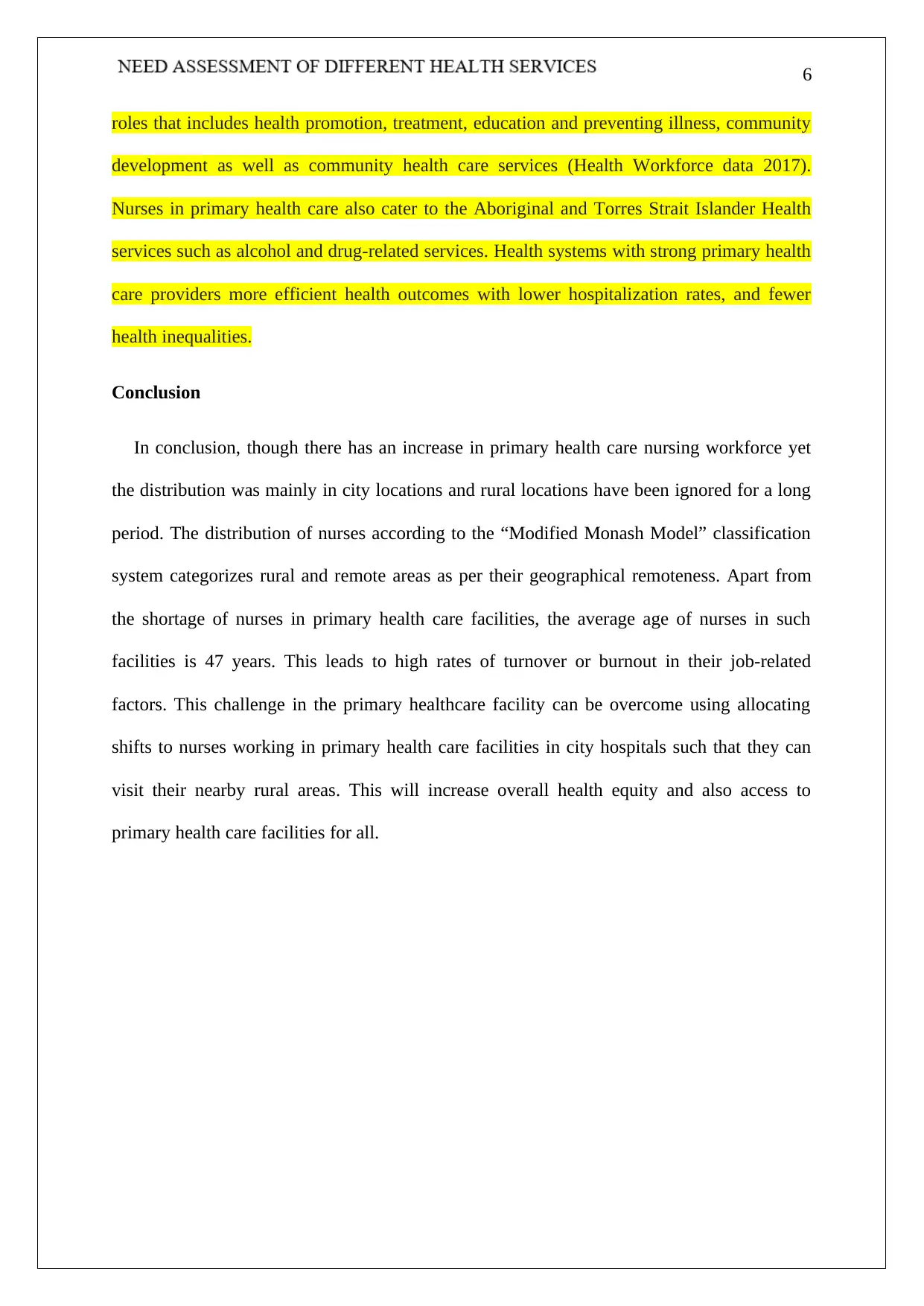
6
roles that includes health promotion, treatment, education and preventing illness, community
development as well as community health care services (Health Workforce data 2017).
Nurses in primary health care also cater to the Aboriginal and Torres Strait Islander Health
services such as alcohol and drug-related services. Health systems with strong primary health
care providers more efficient health outcomes with lower hospitalization rates, and fewer
health inequalities.
Conclusion
In conclusion, though there has an increase in primary health care nursing workforce yet
the distribution was mainly in city locations and rural locations have been ignored for a long
period. The distribution of nurses according to the “Modified Monash Model” classification
system categorizes rural and remote areas as per their geographical remoteness. Apart from
the shortage of nurses in primary health care facilities, the average age of nurses in such
facilities is 47 years. This leads to high rates of turnover or burnout in their job-related
factors. This challenge in the primary healthcare facility can be overcome using allocating
shifts to nurses working in primary health care facilities in city hospitals such that they can
visit their nearby rural areas. This will increase overall health equity and also access to
primary health care facilities for all.
roles that includes health promotion, treatment, education and preventing illness, community
development as well as community health care services (Health Workforce data 2017).
Nurses in primary health care also cater to the Aboriginal and Torres Strait Islander Health
services such as alcohol and drug-related services. Health systems with strong primary health
care providers more efficient health outcomes with lower hospitalization rates, and fewer
health inequalities.
Conclusion
In conclusion, though there has an increase in primary health care nursing workforce yet
the distribution was mainly in city locations and rural locations have been ignored for a long
period. The distribution of nurses according to the “Modified Monash Model” classification
system categorizes rural and remote areas as per their geographical remoteness. Apart from
the shortage of nurses in primary health care facilities, the average age of nurses in such
facilities is 47 years. This leads to high rates of turnover or burnout in their job-related
factors. This challenge in the primary healthcare facility can be overcome using allocating
shifts to nurses working in primary health care facilities in city hospitals such that they can
visit their nearby rural areas. This will increase overall health equity and also access to
primary health care facilities for all.
⊘ This is a preview!⊘
Do you want full access?
Subscribe today to unlock all pages.

Trusted by 1+ million students worldwide
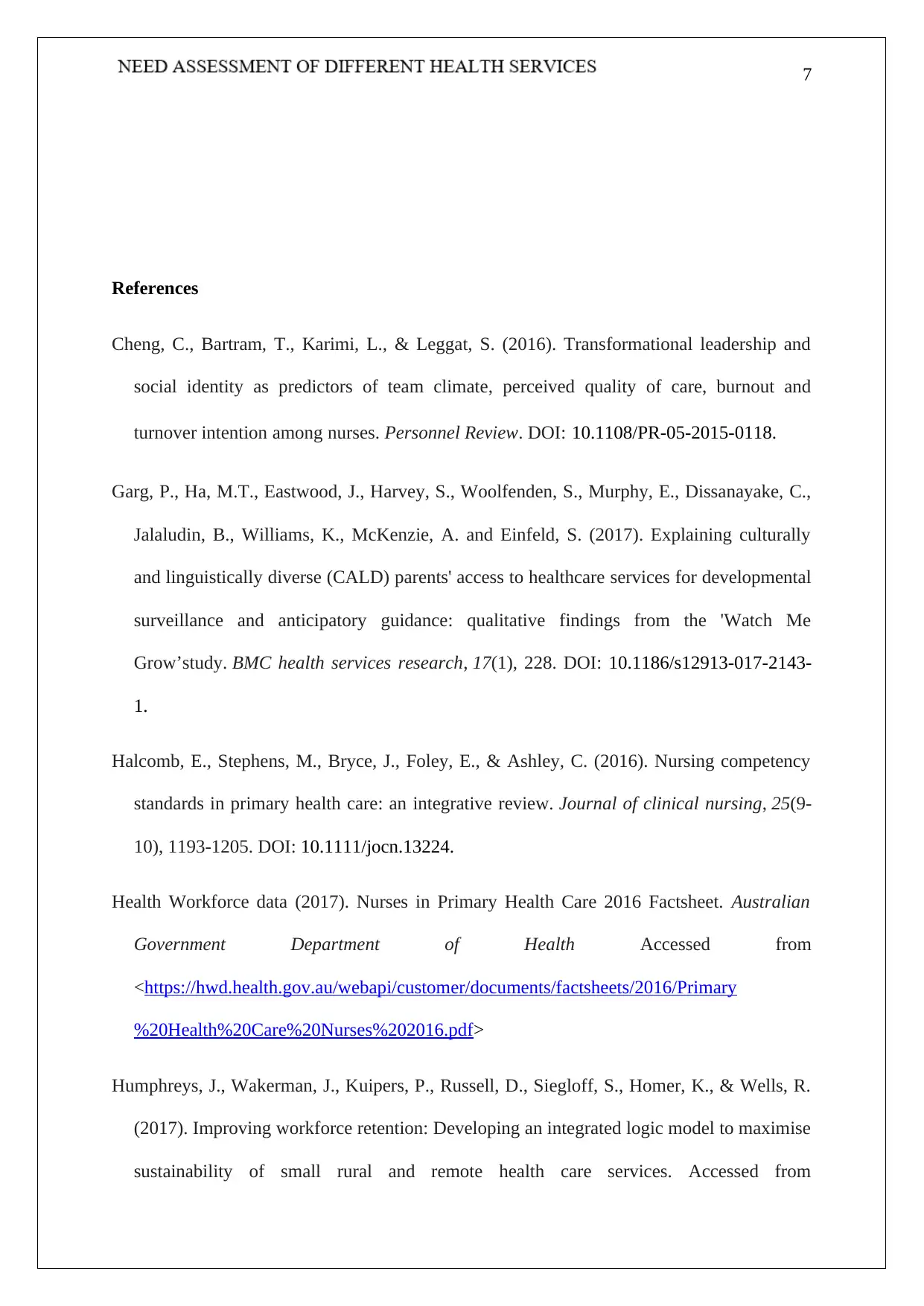
7
References
Cheng, C., Bartram, T., Karimi, L., & Leggat, S. (2016). Transformational leadership and
social identity as predictors of team climate, perceived quality of care, burnout and
turnover intention among nurses. Personnel Review. DOI: 10.1108/PR-05-2015-0118.
Garg, P., Ha, M.T., Eastwood, J., Harvey, S., Woolfenden, S., Murphy, E., Dissanayake, C.,
Jalaludin, B., Williams, K., McKenzie, A. and Einfeld, S. (2017). Explaining culturally
and linguistically diverse (CALD) parents' access to healthcare services for developmental
surveillance and anticipatory guidance: qualitative findings from the 'Watch Me
Grow’study. BMC health services research, 17(1), 228. DOI: 10.1186/s12913-017-2143-
1.
Halcomb, E., Stephens, M., Bryce, J., Foley, E., & Ashley, C. (2016). Nursing competency
standards in primary health care: an integrative review. Journal of clinical nursing, 25(9-
10), 1193-1205. DOI: 10.1111/jocn.13224.
Health Workforce data (2017). Nurses in Primary Health Care 2016 Factsheet. Australian
Government Department of Health Accessed from
<https://hwd.health.gov.au/webapi/customer/documents/factsheets/2016/Primary
%20Health%20Care%20Nurses%202016.pdf>
Humphreys, J., Wakerman, J., Kuipers, P., Russell, D., Siegloff, S., Homer, K., & Wells, R.
(2017). Improving workforce retention: Developing an integrated logic model to maximise
sustainability of small rural and remote health care services. Accessed from
References
Cheng, C., Bartram, T., Karimi, L., & Leggat, S. (2016). Transformational leadership and
social identity as predictors of team climate, perceived quality of care, burnout and
turnover intention among nurses. Personnel Review. DOI: 10.1108/PR-05-2015-0118.
Garg, P., Ha, M.T., Eastwood, J., Harvey, S., Woolfenden, S., Murphy, E., Dissanayake, C.,
Jalaludin, B., Williams, K., McKenzie, A. and Einfeld, S. (2017). Explaining culturally
and linguistically diverse (CALD) parents' access to healthcare services for developmental
surveillance and anticipatory guidance: qualitative findings from the 'Watch Me
Grow’study. BMC health services research, 17(1), 228. DOI: 10.1186/s12913-017-2143-
1.
Halcomb, E., Stephens, M., Bryce, J., Foley, E., & Ashley, C. (2016). Nursing competency
standards in primary health care: an integrative review. Journal of clinical nursing, 25(9-
10), 1193-1205. DOI: 10.1111/jocn.13224.
Health Workforce data (2017). Nurses in Primary Health Care 2016 Factsheet. Australian
Government Department of Health Accessed from
<https://hwd.health.gov.au/webapi/customer/documents/factsheets/2016/Primary
%20Health%20Care%20Nurses%202016.pdf>
Humphreys, J., Wakerman, J., Kuipers, P., Russell, D., Siegloff, S., Homer, K., & Wells, R.
(2017). Improving workforce retention: Developing an integrated logic model to maximise
sustainability of small rural and remote health care services. Accessed from
Paraphrase This Document
Need a fresh take? Get an instant paraphrase of this document with our AI Paraphraser
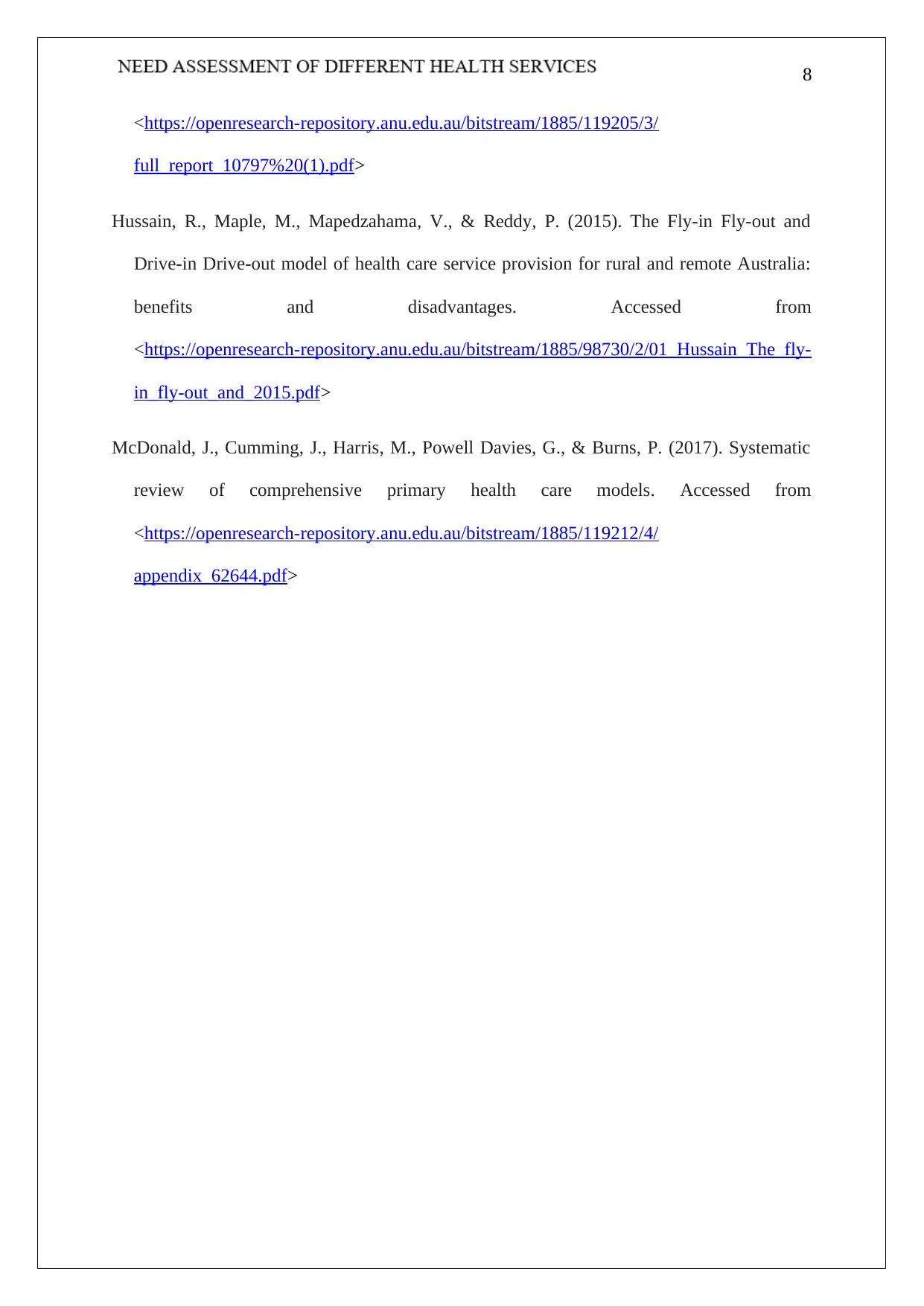
8
<https://openresearch-repository.anu.edu.au/bitstream/1885/119205/3/
full_report_10797%20(1).pdf>
Hussain, R., Maple, M., Mapedzahama, V., & Reddy, P. (2015). The Fly-in Fly-out and
Drive-in Drive-out model of health care service provision for rural and remote Australia:
benefits and disadvantages. Accessed from
<https://openresearch-repository.anu.edu.au/bitstream/1885/98730/2/01_Hussain_The_fly-
in_fly-out_and_2015.pdf>
McDonald, J., Cumming, J., Harris, M., Powell Davies, G., & Burns, P. (2017). Systematic
review of comprehensive primary health care models. Accessed from
<https://openresearch-repository.anu.edu.au/bitstream/1885/119212/4/
appendix_62644.pdf>
<https://openresearch-repository.anu.edu.au/bitstream/1885/119205/3/
full_report_10797%20(1).pdf>
Hussain, R., Maple, M., Mapedzahama, V., & Reddy, P. (2015). The Fly-in Fly-out and
Drive-in Drive-out model of health care service provision for rural and remote Australia:
benefits and disadvantages. Accessed from
<https://openresearch-repository.anu.edu.au/bitstream/1885/98730/2/01_Hussain_The_fly-
in_fly-out_and_2015.pdf>
McDonald, J., Cumming, J., Harris, M., Powell Davies, G., & Burns, P. (2017). Systematic
review of comprehensive primary health care models. Accessed from
<https://openresearch-repository.anu.edu.au/bitstream/1885/119212/4/
appendix_62644.pdf>
1 out of 8
Related Documents
Your All-in-One AI-Powered Toolkit for Academic Success.
+13062052269
info@desklib.com
Available 24*7 on WhatsApp / Email
![[object Object]](/_next/static/media/star-bottom.7253800d.svg)
Unlock your academic potential
Copyright © 2020–2025 A2Z Services. All Rights Reserved. Developed and managed by ZUCOL.





